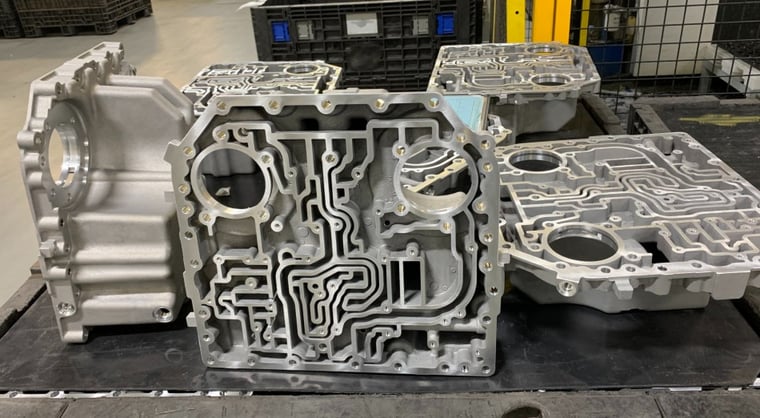When designing a machined part, one of the main considerations is its material. Aluminum alloys are commonly used in CNC machining for a variety of industries and applications. However, before it can be shaped into precision parts, it must first undergo one of several casting processes.
Each casting method offers unique advantages and considerations. This article explores the pros and cons of aluminum CNC machining and provides an overview of the most common casting techniques and why each might be recommended for a project.
Benefits of Aluminum CNC Machining
Customers often choose aluminum for its visual appeal because it can achieve a high-shine finish. Most aluminum alloys are also highly corrosion-resistant and may not require painting or finishing. And, of course, aluminum is well known for its strength-to-weight ratio; it’s ideal for applications requiring lightweight materials, such as those in the auto and aerospace industries. Because aluminum is more conductive than most other types of metals (with the exception of copper), it’s often used in electrical components and enclosures.
From a CNC machining standpoint, aluminum has several advantages. It’s easier to machine because it chips more easily and is generally easier to shape, leading to faster cycle times. It also requires less deburring during the finishing process. Because it’s not as hard as steel or iron, the tools used to machine aluminum last dramatically longer before requiring replacement. In the end, it requires less labor and can be a good choice for high-volume part orders.
Potential Downsides of Aluminum CNC Machining
While aluminum boasts a high strength-to-weight ratio, it’s still not as strong as iron or steel. And, while aluminum is easy to machine, it can be more difficult to weld and maintain tight tolerances because it tends to flex unevenly when exposed to high temperatures.
The porosity of aluminum can also be an issue, and components with inclusions that are exposed to certain chemicals can weaken, making them more prone to leaking. Alloys must be properly selected and quality controls must be put in place to prevent such issues. And we can’t ignore the fact that aluminum can be more costly than iron or steel. Applications that don’t require lightweight materials or high-quality finishes sometimes opt for iron or steel. That’s why you often see iron used in tractors and other agricultural equipment.
4 Common Aluminum Metal Casting Techniques
The casting methods for aluminum play a critical role in selecting the type of alloy. Here at Stecker, we work with many foundries located in the heart of the Midwest in addition to some international partners. Raw aluminum alloy materials require casting prior to machining them down into the precision parts required for an application. The most common metal casting techniques include the following:
1. High-Pressure Die Casting
The die-casting method injects molten aluminum into a steel mold at high pressure, which quickly solidifies into the final part's shape. The molds, or dies, are reusable, making them suitable for large production runs.
Why choose it? You might opt for high-pressure die casting if you need to produce large quantities of complex, tight-tolerance, and smooth-surface parts. It's appropriate for quicker turnaround times and has fewer finishing requirements.
2. Permanent Mold Casting
Similarly to die casting, permanent mold casting uses a steel mold to form aluminum into a desired shape. The difference is that for permanent mold casting, the molten aluminum is poured into the mold and fills the mold using gravity. Die casting, on the other hand, uses high pressure to inject liquid aluminum into the mold.
Why choose it? Permanent mold casting can take longer than die casting, but it might be a good choice for applications that require less porosity (smoother surfaces) and higher strength.
3. Sand Casting
Sand casting is the most common type of casting. As its name suggests, molten aluminum is poured into a sand mold. Once cooled, the mold is removed to reveal the product which is sent on for final machining and finishing.
Why choose it? Sand casting has lower upfront tooling costs and can be appropriate for small-quantity orders. It can even be used for prototypes or large components that are difficult to cast by other methods. In general, however, sand casting results in a rougher finish and it’s more difficult to achieve tight tolerances, potentially requiring additional machining and finishing.
4. Lost Foam Casting
Lost foam casting uses a foam pattern that evaporates when the molten aluminum is poured into the mold. This method allows for complex geometries and parts with hollow sections without the need for cores.
Why choose it? Lost foam casting is preferred for complex geometries and generally won’t require as much machining. It’s often chosen for intricate, high-tolerance designs in larger quantities.
RELATED: The Importance of Metal Casting for Quality Machined Parts
Determining Which Aluminum Alloy to Use
Pure aluminum is a very soft material, making it unsuitable for CNC applications. Aluminum alloys address this issue by improving ductility. Sometimes the type of alloy will determine the type of casting method. For example, 380 or 413 aluminum alloys are best suited for high-pressure die casting but cannot be sand cast because their strength will be compromised. A 319 alloy is best for sand casting because it doesn’t require heat treatment, which also contributes to lower costs. Other alloys appropriate for sand-casting are 333 and 356.
Knowing which aluminum alloy to use isn’t always cut-and-dried. A CNC machine company might recommend one type of aluminum alloy or casting method over another based on the complexity of the design, required precision, production volume, cost-effectiveness, or other factors. To explore how a CNC machine shop will work with you to determine next steps, check out our CNC Machine Shop Guide.
When a customer comes to us with a part design, our machining experts help them determine the ideal and most economical materials and methods to use. Wondering which type of material or casting method is appropriate for your design? Contact the team at Stecker for a complimentary consultation and quote today.







